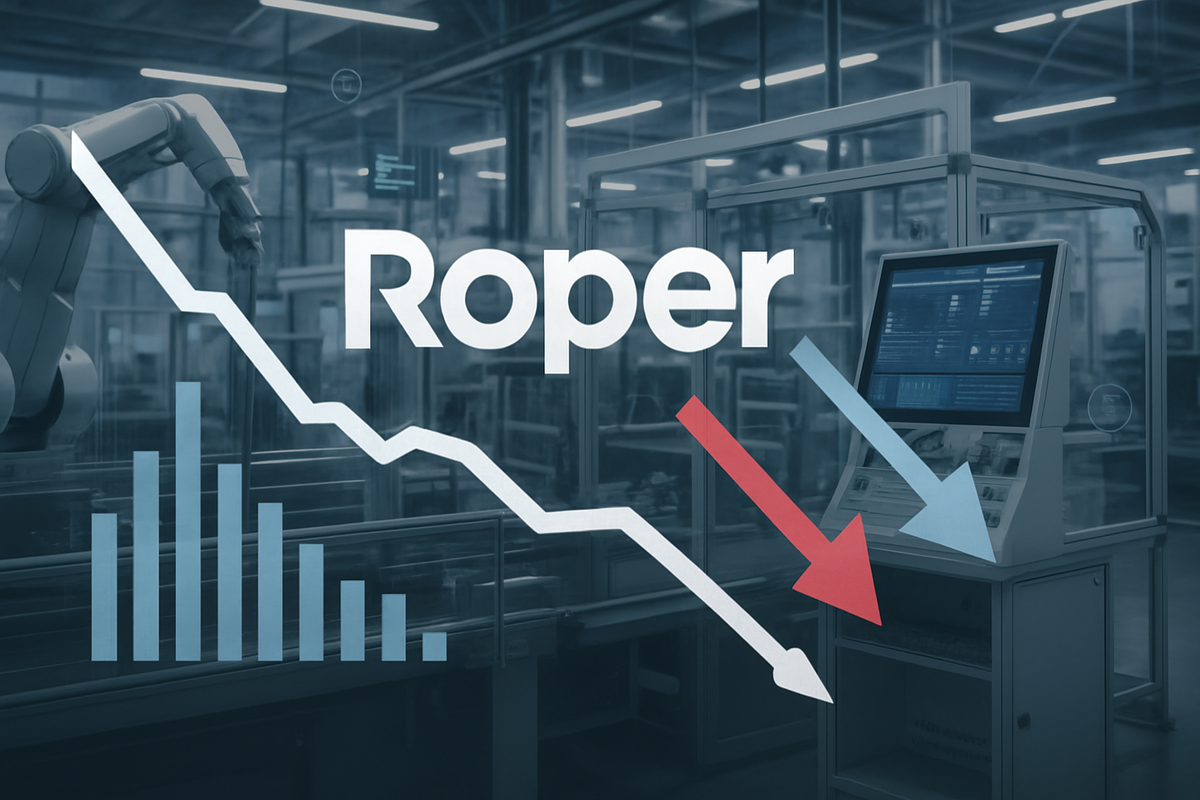
New York, NY – October 23, 2025 – Oppenheimer has recalibrated its outlook for industrial technology stalwart Roper Technologies (NYSE: ROP), lowering its stock price target from $640.00 to $570.00, though maintaining an "Outperform" rating. This adjustment comes in the wake of Roper's third-quarter earnings report, which presented a mixed bag of results and a subsequent downward revision to the company's organic growth projections. The move signals a cautious stance from the investment bank, prompting an immediate negative reaction from the market and stirring discussions across the broader industrial technology sector regarding growth expectations and valuation multiples.
The analyst's decision reflects a growing sensitivity to corporate guidance in a volatile economic climate. While Roper's adjusted earnings per share (EPS) for Q3 2025 marginally surpassed analyst expectations, revenue fell slightly short, and more critically, the company's forward-looking guidance for both the fourth quarter and the full year 2025 was trimmed. This cautious forecast, coupled with specific operational headwinds and a broader "reset in software multiples," has prompted Oppenheimer to revise its valuation, suggesting that even robust companies like Roper are not immune to market pressures and recalibrated growth narratives.
Deconstructing the Downgrade: A Closer Look at Roper's Q3 and Oppenheimer's Rationale
Oppenheimer's revised price target for Roper Technologies (NYSE: ROP) was primarily influenced by a confluence of factors stemming from the company's third-quarter 2025 performance and its forward-looking statements. The industrial technology giant reported adjusted EPS of $5.14, a slight beat against the $5.11 consensus. However, this positive was overshadowed by a revenue figure of $2.02 billion, which narrowly missed the $2.03 billion analyst estimate. The more significant concern arose from Roper's updated guidance: fourth-quarter adjusted EPS was projected between $5.11 and $5.16, falling short of the $5.23 consensus, and the full-year 2025 EPS guidance was narrowed to $19.90-$19.95, down from a previous range and below the analyst average of $19.99.
Several specific headwinds were cited by both Roper and Oppenheimer. The company experienced disruptions from a government shutdown impacting its Deltek business, and copper tariffs led to contract delays at Neptune, one of its diverse portfolio companies. Furthermore, dilution from third-quarter tuck-in acquisitions contributed to a $0.10 reduction at the high end of its EPS guidance. Oppenheimer also highlighted a broader "reset in software multiples," indicating a more conservative valuation environment for software-centric businesses within the industrial technology space. This combination of a slight revenue miss, reduced guidance, specific operational challenges, and a tougher valuation landscape collectively informed Oppenheimer's decision to lower the price target.
The immediate market reaction was swift and negative. Following the announcement of Roper's Q3 results and the revised guidance, Roper Technologies' shares experienced a notable decline, falling 4.71% in pre-market trading. This sharp drop underscored investor sensitivity to any signs of decelerating growth or increased uncertainty, particularly from a company that has historically been a strong performer. The action by Oppenheimer, a respected voice in the financial community, served to amplify these concerns, prompting investors to reassess Roper's near-term growth trajectory and valuation.
Despite these challenges, Roper's Q3 2025 report also showcased underlying strengths. The company achieved a 14% increase in total revenue to $2.02 billion, with 6% organic growth and an 8% contribution from acquisitions. Profitability metrics remained robust, with adjusted EBITDA climbing 13% to $810 million, and adjusted net earnings rising 12% to $557 million. Operating cash flow surged 15% to $870 million, and free cash flow increased 17% to $842 million. In a strong vote of confidence, Roper's Board of Directors authorized a new $3 billion share repurchase program, the first in its history, signaling management's belief in the company's intrinsic value and commitment to shareholder returns. The company is also actively integrating artificial intelligence (AI) products across its various businesses, including Aderant, CentralReach, and Deltek, and maintains over $5 billion in available capital for future acquisitions, indicating a continued strategic focus on growth through M&A.
Market Ripple Effects: Who Wins and Loses in the Industrial Tech Arena
Oppenheimer's recalibration of Roper Technologies' (NYSE: ROP) stock target sends a clear signal to the broader industrial technology sector: even high-quality, diversified players are subject to scrutiny amidst macroeconomic headwinds and evolving valuation paradigms. For Roper itself, the immediate impact is a dent in investor confidence and a stock trading near its 52-week low, despite strong underlying financial health and a new share repurchase program. While the "Outperform" rating suggests Oppenheimer still sees long-term value, the lowered target reflects a more conservative near-term growth outlook. This could lead to continued pressure on Roper's stock in the short term, as investors digest the revised guidance and the implications of a "reset in software multiples" for its substantial software portfolio. However, Roper's robust cash flow, strategic AI initiatives, and significant acquisition war chest position it to potentially capitalize on market dislocations and emerge stronger in the long run.
The implications for competitors within the industrial technology and diversified industrial sectors are multifaceted. Companies with significant exposure to government contracts, such as those affected by shutdowns, or those reliant on materials subject to tariffs, may face similar investor apprehension. The "reset in software multiples" could particularly affect other industrial software providers or diversified industrial companies with large software segments, potentially leading to broader sector-wide valuation adjustments. Investors might become more discerning, favoring companies with consistently strong organic growth, clear paths to profitability, and resilience against external economic shocks. Companies that can demonstrate robust demand for their products and services, irrespective of broader economic volatility, might see their relative valuations improve.
Conversely, this event could create opportunities for certain players. Competitors with more optimistic guidance or those demonstrating superior execution in challenging environments might attract capital diverted from companies like Roper. Furthermore, the emphasis on AI integration by Roper highlights a critical trend; companies in the industrial technology space that are successfully embedding AI into their offerings could be seen as long-term winners, potentially commanding higher valuations. For private companies or smaller players, this period of market recalibration could also present acquisition opportunities for well-capitalized entities like Roper, allowing them to consolidate market share or acquire innovative technologies at potentially more attractive valuations.
Broader Significance: Industry Trends and Economic Undercurrents
Oppenheimer's adjustment to Roper Technologies' (NYSE: ROP) price target is more than just an isolated event; it resonates with several broader industry trends and economic undercurrents shaping the financial markets in late 2025. The explicit mention of a "reset in software multiples" by Oppenheimer underscores a significant shift in how the market values software companies, including those embedded within diversified industrial conglomerates. For years, software companies enjoyed premium valuations based on high growth expectations. However, as interest rates have risen and economic growth has moderated, investors are increasingly scrutinizing profitability and sustainable free cash flow, leading to a more conservative multiple environment. This trend could exert downward pressure on other industrial technology firms with substantial software segments, forcing a re-evaluation of their growth strategies and financial targets.
The challenges faced by Roper, such as the government shutdown impacting its Deltek business and copper tariffs affecting Neptune, highlight the persistent influence of macroeconomic and geopolitical factors on corporate performance. These external headwinds are not unique to Roper; many companies across various sectors are grappling with supply chain disruptions, inflationary pressures, and unpredictable policy environments. The event serves as a stark reminder that even diversified portfolios are susceptible to these broader forces, emphasizing the importance of resilient supply chains, adaptable business models, and effective risk management strategies. The ripple effect could see investors favoring companies with less exposure to volatile government contracts or those with diversified global supply chains that can mitigate the impact of localized tariffs and trade disputes.
Historically, analyst target adjustments and market reactions to revised corporate guidance are common occurrences, particularly during periods of economic uncertainty. Similar events have often preceded broader market corrections or shifts in sector leadership. The current situation with Roper could be compared to past instances where industrial giants faced pressure due to cyclical downturns or specific policy changes, leading to a re-evaluation of their long-term growth prospects. Regulatory or policy implications, such as the impact of tariffs, underscore the increasing intertwining of government actions and corporate profitability. Companies must now navigate a complex regulatory landscape, where policy decisions can directly affect their operational costs and market access, making robust public affairs strategies as critical as operational efficiency.
The Road Ahead: Navigating Uncertainty and Embracing Innovation
Looking ahead, Roper Technologies (NYSE: ROP) faces a pivotal period characterized by both challenges and opportunities. In the short term, the company may continue to experience investor skepticism as the market digests the revised guidance and the implications of a tighter valuation environment for software assets. The stock could remain volatile, potentially trading within a narrower range until there are clearer signs of a rebound in organic growth or significant progress on strategic initiatives. For the long term, however, Roper's robust cash flow generation, strategic focus on high-margin software businesses, and substantial capital available for acquisitions position it for potential recovery and continued growth. The authorized $3 billion share repurchase program also signals management's confidence and could provide a floor for the stock price.
Potential strategic pivots or adaptations required for Roper include an intensified focus on accelerating organic growth within its existing portfolio, particularly in its software segments. This could involve increased investment in R&D, enhanced customer acquisition strategies, and deeper integration of artificial intelligence (AI) across its product offerings, as already indicated by its initiatives in Aderant, CentralReach, and Deltek. Furthermore, Roper's disciplined M&A strategy will be crucial. With over $5 billion in available capital, the company is well-positioned to acquire complementary businesses that can bolster its market position, expand its technological capabilities, or provide new avenues for growth, potentially at more attractive valuations given the "reset in software multiples."
Market opportunities may emerge from increased demand for digital transformation solutions in industrial settings, which Roper's software businesses are well-equipped to provide. As industries continue to embrace automation and data analytics, Roper's integrated solutions could see renewed interest. Challenges will include navigating persistent macroeconomic headwinds, managing inflationary pressures, and adapting to a potentially sustained period of higher interest rates. Potential scenarios range from a gradual recovery driven by strong execution and strategic acquisitions, leading to a re-rating of the stock, to a more prolonged period of sideways trading if economic uncertainties persist and organic growth remains subdued.
A Comprehensive Wrap-Up: Key Takeaways and Investor Watch Points
Oppenheimer's decision to lower its stock price target for Roper Technologies (NYSE: ROP) serves as a significant marker for the industrial technology sector, highlighting the evolving dynamics of market valuation and the impact of macroeconomic factors. The key takeaways from this event include the growing importance of consistent organic growth, the sensitivity of investor sentiment to revised corporate guidance, and the ongoing "reset in software multiples" that is reshaping valuations across technology-heavy industries. While Roper's Q3 results showed mixed performance with a revenue miss and reduced forward guidance, the company simultaneously demonstrated strong underlying profitability, robust cash flow, and a commitment to shareholder returns through its first-ever $3 billion share repurchase program.
Moving forward, the market will closely assess Roper's ability to navigate the cited headwinds—such as government shutdowns and tariffs—and to accelerate organic growth within its diverse portfolio. The company's strategic integration of AI across its businesses and its continued pursuit of tuck-in acquisitions will be critical determinants of its future performance. The "Outperform" rating maintained by Oppenheimer suggests that while the near-term outlook has been adjusted, the fundamental strength and long-term potential of Roper are still recognized. This indicates that the target reduction is more a reflection of a recalibrated valuation environment and specific operational challenges rather than a fundamental erosion of the company's business model.
Investors should watch for several key indicators in the coming months. These include future earnings reports, paying close attention to organic revenue growth rates and any further revisions to guidance. Updates on the progress of AI integration and the impact of recent and future acquisitions will also be crucial. Furthermore, the utilization of the new share repurchase program could signal management's confidence and potentially support the stock price. The broader industrial technology sector will also be under scrutiny, as investors seek to identify companies that can demonstrate resilience, adaptability, and sustainable growth in a complex and evolving economic landscape. Roper Technologies, with its blend of challenges and strategic strengths, remains a bellwether for the sector's trajectory.
This content is intended for informational purposes only and is not financial advice





